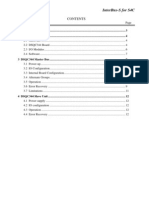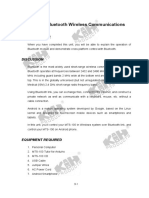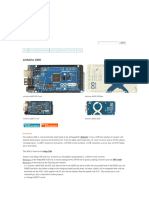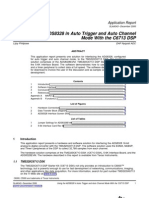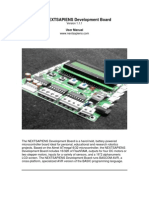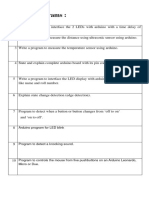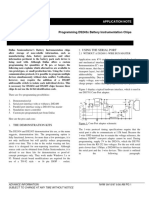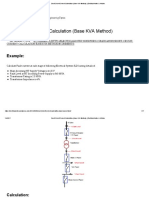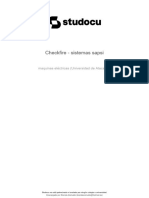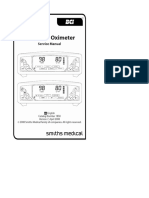Ch2 - BaseBoard Descriprion
Ch2 - BaseBoard Descriprion
Uploaded by
Edward ConalCopyright:
Available Formats
Ch2 - BaseBoard Descriprion
Ch2 - BaseBoard Descriprion
Uploaded by
Edward ConalOriginal Description:
Copyright
Available Formats
Share this document
Did you find this document useful?
Is this content inappropriate?
Copyright:
Available Formats
Ch2 - BaseBoard Descriprion
Ch2 - BaseBoard Descriprion
Uploaded by
Edward ConalCopyright:
Available Formats
1
2. The STM32F4-Discovery BaseBoard
The description of the extension board based on the STM32F Discovery is given in this chapter. Full
schematic diagrams and PCB layouts are presented, including figures on signal connections.
2.1. The processor board
There are many different kinds of microcontrollers available, and all are optimal from a certain
point of view.
The experiments that are to be performed in this course require a microcontroller that is capable
of typical data processing tasks in real time; the processor must be fast, preferably 32 bit type. Analog
signals will be used as a source of information, therefore the microcontroller must be capable of
converting analog signals to digital values and back. Additionally, the microcontroller should have
provisions for typical buses as used in contemporary interfacing, like I2C, SPI, and RS232. An exchange
of data between the microcontroller and a personal computer must be feasible.
The microcontroller is to be programmed using a free version of compiler, the preferred
programming language is C. No operating system will be used. The hardware needed for
programming of the microcontroller should be freely available.
Due to its convenient properties and low price the STM32F4-Discovery demo board is selected for
this course. The demo board can be obtained for as low as 15, and includes the microcontroller
STM32F407VGT (32bit, ARM Cortex-M4F core, 1MB Flash memory, 192kB RAM), some interfacing
hardware, and the programmer. The board is powered through an USB connector from a host personal
computer. Most of the microcontroller pins are available at two header connectors on the board. The
board can be used without any additional hardware, and the detailed description is given at:
http://www.st.com/web/catalog/tools/FM116/SC959/SS1532/PF252419 (as of Nov. 2013)
2.2. The extension - BaseBoard
The STM32F4-Discovery board hosts a microcontroller with most of its pins exposed at the header
connectors, Fig. 2.2. In order to prevent damage caused by either static electricity or experimenting
faults a BaseBoard has been prepared. This board is a EURO size printed circuit board with header
sockets that accept headers of the STM32F4-Discovery board, and includes protection circuits and
additional hardware to improve the interfacing experience, see Fig. 2.2.13 for signal names at header
pins.
2.2.1.
The BaseBoard power supply, Fig. 2.2.1
The power to run STM32F4-Discovery board is normally supplied from a USB cable connected to a
personal computer (PC). However, there are times when the board is to be used without the
connection to the PC, and in such cases the board needs an alternative power supply. This can be any
source capable of providing a voltage between 8V and 25V, 0.25A min. This source can be connected
to the BaseBoard using pads B200 and B201; there is a protective diode D270 to prevent damage due
The STM32F4-Discovery BaseBoard
to the incorrect polarity, and a LED D242 to signal the presence of the external power source. The
BaseBoard includes a regulator LM7805 (U800) to reduce the applied voltage to 5V as required to
power the Discovery board. There are several decoupling capacitors added on the board. The input
voltage is used also for the driving of the power outputs from the BaseBoard.
The regulated +5V voltage should not be applied to the Discovery board simultaneously
with a voltage from a USB cable. A jumper J802 is used to disconnect the external power
supply when the USB cable is attached to the Discovery board.
Fig. 2.2.1: The BaseBoard power supply
2.2.2.
The switches, Fig. 2.2.2
There are four push-button switches S370 to S373
mounted on the BaseBoard, these can be used by the
user program as required. Switches are pull-up type,
and are connected to the microcontroller port E, pins
PE3 to PE6. The user software should declare these
pins as inputs with active pull-down. Resistors R370
to R373 are inserted between switches and the
microcontroller to prevent damage to the
microcontroller in case of false programming.
2.2.3.
Figure 2.2.2: The switches
The alphanumerical liquid crystal display (LCD), Fig. 2.2.3
An alphanumerical LCD is mounted on the
BaseBoard. The LCD is a standard 16 character 2 line
display, and can be accessed through four data
(PD3:LCD_D3/7 to PD0:LCD_D0/4) and two control
lines (PD6:LCD_E, PD7:LCD_RS), all connected to port
D. The contrast of the displayed characters can be
adjusted using the trimmer P350.
The LCD is powered by +5V, but accepts 3V signals
from the microcontroller. The writing on the display
requires rather complex routines, and these have
been prepared in advance as a file to be included in
the user program (LCD2x16.c).
Figure 2.2.3: The alphanumerical LCD
The STM32F4-Discovery BaseBoard
2.2.4.
The interface I2C, Fig. 2.2.4
The interface bus I2C uses two signals
SCL and SDA. The hardware to manage these
two signals is built into the microcontroller
(block number 1 for I2C is used), and the two
signals are available at port B, pins
PB6:I2C1_SCL and PB7:I2C1_SDA. The bus
signals are available at connector K460 at
the edge of the BaseBoard.
Two resistors R461 and R463 are added
at the BaseBoard as a pull-up resistors as
Figure 2.2.4: The interface I2C
required by the I2C standard. Two resistors
R460 and R261 in connection with diodes D460 and D461 are inserted as protective elements.
2.2.5.
The interface SPI, Fig. 2.2.5
The interface bus SPI uses four signals SCK, MISO, MOSI and SEL. Two SPI connectors are
implemented, therefore two select signals SEL are needed. The hardware to manage all these signals
is built into the microcontroller (block number 2 for SPI is used), and signals are available at port B,
Figure 2.2.5: The interface SPI, two times
pins PB13:SPI2_SCK, PB14:SPI2_MISO, PB15:SPI2_MOSI. The two select signals are available at
PB12:SPI2_SEL1 and PB11:SPI2_SEL2. The bus signals are available at connectors K480 and K485
respectively.
Five resistors R480 to R485 together with five diodes D480 to D485 are added as protective
elements to reduce the chance of harming the microcontroller.
2.2.6.
The interface RS232, Fig. 2.2.6
The interface bus RS232 uses two signals RX and TX.
The hardware to manage these signals is built into the
microcontroller (block number 3 for serial
communication is used here), and signals are available at
port D, pins PD9:USAT3_RX and PD8:USART3_TX. The
signals are available at connector K600 at the edge of the
BaseBoard. The RS232 signals here are TTL compatible
(0V to 3V), and should NOT be connected to the RS232 of
a normal PC. This version of RS232 signals are intended
to be connected to the USB to serial cable FTDI TTL232R-3V3 (or similar).
Figure 2.2.6: The interface RS232
The STM32F4-Discovery BaseBoard
Two resistors R600 and R601 in combination with two diodes D600 and D601 are used as protective
elements.
2.2.7.
General purpose digital input/output, port E, Fig. 2.2.7
Eight lines of port E (PE8 to PE15) are available for digital interfacing, these are available at the
connector K440. The connector additionally offers a power supply of +3V and a power supply of +5V.
Resistor R440 to R447 in combination with diodes D440 to D447 serve as protective elements.
Figure 2.2.7: General purpose digital input/output, port E
2.2.8.
Counters or general purpose digital input/outputs, Fig. 2.2.8
The microcontroller houses several counters/timers. The connections to some of them are available
at the connector K406. The same can be used as general purpose digital input/output when counters
are not required.
Resistors R406 to R411 in combination with diodes D406 to D411 serve as protective elements.
Figure 2.2.8: Counters or general purpose digital input/outputs
2.2.9.
Analog output, Fig. 2.2.9
The microcontroller hosts two DACs (12 bit resolution), their outputs are available at port A,
PA4:DAC1_OUT and PA5:DAC2_OUT. These pins of port A must be declared properly to serve as analog
outputs. The signals from these pins are buffered and filtered using two operational amplifiers and
passive RC filters, and are finally available at connector K300. The range of output voltages is from 0V
to +2.5V, the output current is limited by the internal circuitry of the operational amplifier U320.
The STM32F4-Discovery BaseBoard
The pins PA4 and PA5 are used on the STM23F4-Discovery board to drive
digital inputs of peripheral chips. In order to fully utilize the properties of DAC, the
PCB traces to these peripheral chips should be cut.
Figure 2.2.9: Analog output
2.2.10.
Analog input, Fig. 2.2.10
The microcontroller hosts three ADCs (12 bit resolution each), and three multiplexers to connect
signals from several pins of the microcontroller to each of them. The BaseBoard utilizes four pins to
measure external analog signals, these are PA1:ADC123_IN1, PA2:ADC123_IN2, PC1:ADC123_IN11,
and PC2:ADC123_IN12. These pins must be initialized to analog mode prior to the use of the ADC
function, and external analog signals can be connected to connector K300.
Figure 2.2.10: Analog input, the connector is given in Fig. 2.2.9
The STM32F4-Discovery BaseBoard
Input signals are fed to four identical stages before being passed to the microcontroller. Each stage
consists of a voltage divider (resistors R300, R301, capacitor C301 and jumper J301 for the first stage).
The divider is followed by a unity gain connected operational amplifier U300A and an RC low-pass filter
(R302 and C302). A double diode D301 is connected to the non-inverting input of the operational
amplifier, and serves as a protective element.
The input range depends on the position of the jumper (J301 for the first stage):
-
Jumper not inserted: range is 0V to +3V3 (Vref of the microcontroller)
Jumper shorts R301 to ground: range is 0V to two times +3V3 (2 x Vref of the microcontroller)
Jumper shorts R301 and +3V3: range is -3V3 to +3V3.
Both RC time constants limit the input frequency range to 1MHz.
2.2.11.
Power digital outputs, Fig. 2.2.11
Two lines of port C (PC14 and PC15)
are used to drive MOSFET transistors
Q450 and Q451. The transistors are
connected as pull-down switches where
the drains are available at the connector
K451, Fig. 2.2.11. The same connector
hosts ground and power supply +5V and
+12V. The maximum current for the
MOSFET is 1A.
2.2.12.
Figure 2.2.11: Power digital outputs
Motor driver, Fig. 2.2.12
Five lines of port C (PC6 to PC9 and PC11) are buffered using an integrated circuit U500, and can be
used to drive a stepper motor or two DC motors. The circuit U500 must be enabled prior to the use by
setting its enable input (PC11) high. Buffered signals PC6 to PC19 then appear at connector K500, Fig.
2.2.12. The circuit U500 is supplied by the external power supply +12V applied at B200. The maximum
output current is 800mA.
Figure 2.2.12: Motor driver
2.2.13.
STM23F4-Discovery header signals
The signals at the headers of the STM23F4-Discovery board are given in Fig. 2.2.13.
The STM32F4-Discovery BaseBoard
Figure 2.2.14: Signals at header connectors, STM32F4-Discovery board
The STM32F4-Discovery BaseBoard
Figure 2.2.15: BaseBoard, component layout
The STM32F4-Discovery BaseBoard
Figure 2.2.16: BaseBoard, signals and connectors
The STM32F4-Discovery BaseBoard
Figure 2.2.17: BaseBoard PCB, top view
10
The STM32F4-Discovery BaseBoard
Figure 2.2.18: BaseBoard PCB, top view
11
The STM32F4-Discovery BaseBoard
Figure 2.2.19: Photo of the finished BaseBoard without the STM32F4 Discovery board installed
12
The STM32F4-Discovery BaseBoard
Figure 2.2.19: Photo of the finished BaseBoard with the STM32F4 Discovery board installed
13
You might also like
- Ieee 2778-2020Document24 pagesIeee 2778-2020Cristhian Giovanni Silva OchoaNo ratings yet
- Mini CNC Machine Project ReportDocument32 pagesMini CNC Machine Project ReportNaimish Sukhadeve83% (6)
- Interbus SDocument12 pagesInterbus Sredoctober24No ratings yet
- Acson Digital Variable Multi Units Application ManualDocument116 pagesAcson Digital Variable Multi Units Application ManualDota NgNo ratings yet
- FRGQ Nokia Flexi RRUDocument6 pagesFRGQ Nokia Flexi RRUMiau HuLaaNo ratings yet
- Atmega32 Dev Board - EFY March11 PDFDocument7 pagesAtmega32 Dev Board - EFY March11 PDFsagar_gy100% (1)
- Ipboxb: Ip - Box B E/001 1/20Document20 pagesIpboxb: Ip - Box B E/001 1/20Claudio SaezNo ratings yet
- Akkon Usb Controller BoardDocument6 pagesAkkon Usb Controller Boardthanh_cdt01No ratings yet
- 7.chapter 3Document11 pages7.chapter 3thethtet87No ratings yet
- User Manual - SN-138020 - Atmega-8 Mother BoardDocument11 pagesUser Manual - SN-138020 - Atmega-8 Mother BoardUrsap Buddy100% (1)
- Ug179 Wrb4150b User GuideDocument31 pagesUg179 Wrb4150b User GuideksajjNo ratings yet
- Users Manual Snadpic100 Rev1.00Document18 pagesUsers Manual Snadpic100 Rev1.00drsvastaNo ratings yet
- DS Um232h-BDocument14 pagesDS Um232h-BmoabdolyNo ratings yet
- Useri2c v3-1Document11 pagesUseri2c v3-1Devan AntonyNo ratings yet
- MC 34825Document39 pagesMC 34825chshfeng100% (1)
- 12 PDFsam Manual-PIC-EKDocument12 pages12 PDFsam Manual-PIC-EKSilvanildo Manoel da SilvaNo ratings yet
- 11 Unit09 Bluetooth PDFDocument44 pages11 Unit09 Bluetooth PDFDhudy PolanunuNo ratings yet
- Inter-Integrated Circuit (I2C) : Karthik Hemmanur ECE 480-Design Team 3 Fall 2009Document8 pagesInter-Integrated Circuit (I2C) : Karthik Hemmanur ECE 480-Design Team 3 Fall 2009gluciferNo ratings yet
- ICradio Stick24G (English)Document2 pagesICradio Stick24G (English)Harish HariNo ratings yet
- 006-Module Interface TrayDocument12 pages006-Module Interface TrayalexNo ratings yet
- MSP 4302Document36 pagesMSP 4302jeffzmNo ratings yet
- IPBox B ManualDocument32 pagesIPBox B ManualsaulhalcorNo ratings yet
- Hardware and Software Implementation of Android-Controlled Robotic VehicleDocument21 pagesHardware and Software Implementation of Android-Controlled Robotic VehicleSai Som MeinNo ratings yet
- Datasheet MOD5272 100IRDocument7 pagesDatasheet MOD5272 100IRcarlos jNo ratings yet
- Microcontroller Board Mit USB-Kabel - ENDocument28 pagesMicrocontroller Board Mit USB-Kabel - ENmath.35No ratings yet
- PROJECT Mislestone 1Document8 pagesPROJECT Mislestone 1Kirankumar ReddyNo ratings yet
- Arduino Mega 2560 Rev3 ADKDocument5 pagesArduino Mega 2560 Rev3 ADKholej18237No ratings yet
- Faults Detector For A Wiring System - Arduino-: University Politehnica of BucharestDocument11 pagesFaults Detector For A Wiring System - Arduino-: University Politehnica of BucharestIonut SimaNo ratings yet
- IoT Sensors and Actuators Lab ManualDocument54 pagesIoT Sensors and Actuators Lab Manualsri kanthNo ratings yet
- Arduino Arduino Arduino Arduino 2 2 2 2 Channel Channel Channel Channel Relay Relay Relay Relay Shield Shield Shield ShieldDocument8 pagesArduino Arduino Arduino Arduino 2 2 2 2 Channel Channel Channel Channel Relay Relay Relay Relay Shield Shield Shield ShieldWisnuNo ratings yet
- Design Note DN401: Interfacing CC1020/1 To The MSP430Document12 pagesDesign Note DN401: Interfacing CC1020/1 To The MSP430William Ramos PaucarNo ratings yet
- Pm25LV512-010 DatasheetDocument24 pagesPm25LV512-010 Datasheethenry96sNo ratings yet
- Smart Card LCDDocument6 pagesSmart Card LCDNisanth PaNo ratings yet
- Chapter 1. OverviewDocument58 pagesChapter 1. OverviewmgitecetechNo ratings yet
- Slaa 343Document12 pagesSlaa 343ugmadhuNo ratings yet
- Icd2 DocDocument15 pagesIcd2 Docdag_84No ratings yet
- DPC MaintenanceDocument22 pagesDPC MaintenanceGivan IsmailNo ratings yet
- STM32 H103 ManualDocument17 pagesSTM32 H103 ManualviniciusmoritaNo ratings yet
- USBHOST Rev1r0Document9 pagesUSBHOST Rev1r0b4sura100% (2)
- CPS Lab Report FinalDocument38 pagesCPS Lab Report Finaldevikam230354ecNo ratings yet
- Atmega32 Development BoardDocument30 pagesAtmega32 Development BoardAlishaKorNo ratings yet
- MSP4302Document36 pagesMSP4302Nagesh RangahnumaiahNo ratings yet
- Embedded Sysytem FileDocument52 pagesEmbedded Sysytem FileGagan MaggoNo ratings yet
- Z3 2 4Document104 pagesZ3 2 4Vu Duc Hoan100% (1)
- Atmega328 Arduino UnoDocument29 pagesAtmega328 Arduino Unoanthoniusokoti004No ratings yet
- The NEXTSAPIENS Development Board: User ManualDocument33 pagesThe NEXTSAPIENS Development Board: User ManualHarshit MahajanNo ratings yet
- Esd PracticalDocument37 pagesEsd PracticalPurva SukhwalNo ratings yet
- Chapter 2 MajorDocument15 pagesChapter 2 MajorOm KashyapNo ratings yet
- What Is ESP32 SIM800L BoardDocument14 pagesWhat Is ESP32 SIM800L BoardjackNo ratings yet
- Digital Storage Oscilloscope: GDS-806/810/820/840 Programming ManualDocument89 pagesDigital Storage Oscilloscope: GDS-806/810/820/840 Programming ManualMoneeb ArifNo ratings yet
- Dallas: Using The Serial PortDocument6 pagesDallas: Using The Serial Portxentronic.idNo ratings yet
- ESP8266 - Independent Study - mr945 PDFDocument49 pagesESP8266 - Independent Study - mr945 PDFsaravananNo ratings yet
- BLE 3 Click WebDocument5 pagesBLE 3 Click WebHenrique NunesNo ratings yet
- EasyDspic4 ManualDocument30 pagesEasyDspic4 ManualPaul Vintimilla TapiaNo ratings yet
- 4-20ma Click ManualDocument2 pages4-20ma Click Manualmmarinmr100% (1)
- PCF8582C-2: 1. DescriptionDocument21 pagesPCF8582C-2: 1. DescriptionroozbehxoxNo ratings yet
- 7th Sem Project ReportDocument49 pages7th Sem Project ReportSamridhi GuptaNo ratings yet
- AZ-Micro Controller Atmega328P Board_ENDocument26 pagesAZ-Micro Controller Atmega328P Board_ENxpress89No ratings yet
- Arduino Mega ADK: Getting Startedshop NowDocument7 pagesArduino Mega ADK: Getting Startedshop NowRicardo de reyNo ratings yet
- BluetoothV3 ManualDocument10 pagesBluetoothV3 ManualWashington QuevedoNo ratings yet
- Orca Share Media1617078034640 6782516869006267082Document16 pagesOrca Share Media1617078034640 6782516869006267082Pocong NiñaNo ratings yet
- Microcontroller Bootcamp (7) : The I C BusDocument8 pagesMicrocontroller Bootcamp (7) : The I C BusMikko FagerlundNo ratings yet
- Exploring Arduino: Tools and Techniques for Engineering WizardryFrom EverandExploring Arduino: Tools and Techniques for Engineering WizardryRating: 4.5 out of 5 stars4.5/5 (5)
- Hybrid Correlation PaperDocument6 pagesHybrid Correlation PaperEdward ConalNo ratings yet
- HP 4142Document22 pagesHP 4142Edward ConalNo ratings yet
- PL TonerDocument4 pagesPL TonerEdward ConalNo ratings yet
- Drop Service Locations For Datamini TabletsDocument106 pagesDrop Service Locations For Datamini TabletsEdward ConalNo ratings yet
- Ed 190414Document363 pagesEd 190414Edward ConalNo ratings yet
- Brio Contents v1-43Document26 pagesBrio Contents v1-43Edward ConalNo ratings yet
- HP Surestore Dat40Document2 pagesHP Surestore Dat40Edward ConalNo ratings yet
- Structure & Written Expression Post Test PDFDocument6 pagesStructure & Written Expression Post Test PDFEdward Conal100% (5)
- 9780545248853Document97 pages9780545248853Edward Conal0% (1)
- Powerpoint AmericanaDocument9 pagesPowerpoint AmericanaEdward ConalNo ratings yet
- 3600 System: WattsDocument2 pages3600 System: WattsYorky Manuel GomezNo ratings yet
- Siemens Bs82Document4 pagesSiemens Bs82Novocain82No ratings yet
- Schott Perform Poly 235-250 3bb New Frame Data Sheet en 0412-1Document2 pagesSchott Perform Poly 235-250 3bb New Frame Data Sheet en 0412-1Katherine Morales aNo ratings yet
- SIS 2.0 Maintenance Interval Schedule - Standby (M0124697-02)Document2 pagesSIS 2.0 Maintenance Interval Schedule - Standby (M0124697-02)Carlos U. CallirgosNo ratings yet
- Laser Communication Free SpaceDocument26 pagesLaser Communication Free SpaceKushagraKapoor100% (1)
- Chapter Two Basic Components and Electric CircuitsDocument11 pagesChapter Two Basic Components and Electric CircuitsJerry ComiaNo ratings yet
- Schoeps - Catalogo 2010Document144 pagesSchoeps - Catalogo 2010frantic_59No ratings yet
- Short Circuit Current Calculation (Base KVA Method) - Electrical Notes & ArticlesDocument17 pagesShort Circuit Current Calculation (Base KVA Method) - Electrical Notes & ArticlesAnonymous mNQq7oj100% (1)
- Dlcap DatasheetDocument20 pagesDlcap DatasheetMusa Abdul AzizNo ratings yet
- Sunny Highpower Peak3 125-Us / 150-UsDocument2 pagesSunny Highpower Peak3 125-Us / 150-UsGregorio VillarrealNo ratings yet
- Sr. Phy Imp For Ipe 2024 01-02-24 FinalDocument2 pagesSr. Phy Imp For Ipe 2024 01-02-24 Finalganeshyerramsetti71No ratings yet
- Atpg Coverage LossDocument4 pagesAtpg Coverage LossUmesh ParasharNo ratings yet
- Smdk6410 Cpu BD Schematics Rev1.0Document16 pagesSmdk6410 Cpu BD Schematics Rev1.0kit2100% (2)
- Ansul CheckFire MP-N Electric Detection and Actuation SystemDocument44 pagesAnsul CheckFire MP-N Electric Detection and Actuation SystembrendzamudioNo ratings yet
- Samsung ICR18650 22EDocument12 pagesSamsung ICR18650 22ENicolae PopNo ratings yet
- Measurement of 3phase Power Using Single WattmeterDocument7 pagesMeasurement of 3phase Power Using Single WattmeterArjun AjuNo ratings yet
- Pr2 - Plus Service ManualDocument172 pagesPr2 - Plus Service ManualBryan MaradiagaNo ratings yet
- Topical Advanced Level PhysicsDocument13 pagesTopical Advanced Level PhysicsAde Boy Rogba0% (1)
- Debug 1214Document19 pagesDebug 1214Ali MahrusNo ratings yet
- Honeywell SZL WL Series SpecificationDocument22 pagesHoneywell SZL WL Series SpecificationR NandakumarNo ratings yet
- Carrier Technical SpecificationDocument2 pagesCarrier Technical Specificationkatrina.chongNo ratings yet
- Airborne Integrated Signal Intelligence System: When Results MatterDocument2 pagesAirborne Integrated Signal Intelligence System: When Results Mattersamirsamira928No ratings yet
- Metravi ERT 1501 ERT 1501R Digital Earth Resistance Tester Catalogue Mar23Document1 pageMetravi ERT 1501 ERT 1501R Digital Earth Resistance Tester Catalogue Mar23rdsb.bhatiaNo ratings yet
- 5990 6283enDocument24 pages5990 6283enEhsan RohaniNo ratings yet
- BCI® 3304 Oximeter: Service ManualDocument36 pagesBCI® 3304 Oximeter: Service ManualEdward Pérez ArangurenNo ratings yet
- Installation Check List: No. Description Installation Before AfterDocument1 pageInstallation Check List: No. Description Installation Before AfterAung Thein OoNo ratings yet
- Adobe Photoshop WorkshopDocument67 pagesAdobe Photoshop WorkshopInigo JosephNo ratings yet


